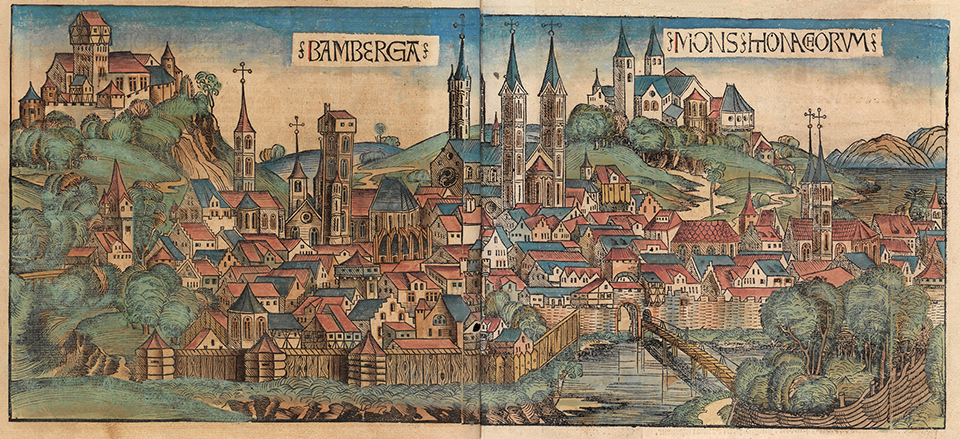On Heinrich II’s birthday in 1012, the abbot at Seeon presented the German king with a panegyric, commonly known as the Carmen Bambergense. The poem provides us with a glimpse of the king’s political and religious program
When the cathedral in the city of Bamberg had been completed, all the leading men of the realm gathered there on the 6th of May, the king’s thirty-fifth birthday, to participate in the consecration. Patriarch, John of Aquileia and more than thirty other bishops undertook the concsecration of this bride of Christ. Though a sinner, I was present as well and saw how the church had been decorated in a manner altogether worthy of the Highest King. After this, there was a great synod … (Thietmar Book 6:60).

In the Carmen Bambergense, the city of Bamberg together with its ruler, Heinrich II, was praised as the “Head of the World”, characterising the new metropolis as “The New Rome”. Likely, the poem was penned as a gift to the King to celebrate the consecration of his new “heavenly city”.
The poem has often been characterised as an urban panegyric. However, the verses outline the city’s virtues less than it defines the role, which the cathedral and the school were intended to play in the larger civilising endeavours projected by Heinrich II. As such it outlines the programmatic goals of the German king, revealed by his creation of Bamberg as a enjoined cathedral and palace complec, in short a “castle”.
The poem was written by Abbot Gerard of Seeon at the Chiemsee, a new foundation from 999. Inhabited by a group of Benedictine monks from St. Emmeran, the new monastery was perhaps envisaged as a northern Reichenau? At least, the abbey’s scriptorium soon gained a reputation for its beautiful illuminated manuscripts. Although the poem was not embelished with grand pictorial art, the penmanship was particularly beatifuld.
Today, the poem functions as an introduction to a manuscript holding a collection of monastic rules, diplomas, and Bede’s Matyrology. However, it is unknown whether the poem was initially penned as an introduction to another manuscript, which is now lost. Likely, the present manuscript was designed and written in the Benedictine Abbey of Seeon as a donation to St. Michelsberg, the monastery founded near Bamberg by Heinrich II.

English translation of the Carmen in laudem Bambergensis civitatis
Beloved ruler, pious King Henry, to your subjects
The shining jewel of the kingdom, the flower of the entire world
radiant by the grace of God, ruling the highest mountains,
at whose nod our life stands secure,
receive this written booklet as commanded,
full of lawgiving statutes of fathers and brothers,
which I, not slow to you but slower to myself, Abbot Gerard,
in name not in merits, and nurturer of the Flock of Seeon,
and although only a trifle, I offer to you as a gift with a vow,
like mixing a drop of dew with the whirls of the sea,
to the summit of the Bamberg Seat to be given,
of which you are named constructor, patron, and leader,
and as a prophetic sign to glorify and extend your name forever.
Now, because you, as our father, wield the sceptre, ruling mightily,
this foundation of our Mother Church flourishes richly.
By royal command, and attuned with the bishop,
she is always adorned with blessed virtuous zeal
while providing the nourishment of law to clerics and people.
This glorious place takes part in the splendour of Jerusalem,
nurtured by the precious blood of the life-giving Christ,
and houses fragments of the cherished cross in golden cases.
[This castle] strives to be equal to the Roman citadel,
providing a resting place for Peter, the first Apostle
and a second home to our Holy Mother Mary,
Also [the cathedral] rejoices to raise up our Lord Jesus,
and Lord of the House is the mighty martyr St. George
from everywhere, numerous great Saints gather,
who will provide endless honour and protection.
The foundations [of this cathedral] are now so great
that the daughter outshines the mother.
and all the known ornaments will please us all.
Not less than the Kirjath Sepher, are you famous for all your learning
In no way are you less regarded as the stoics, rather you outshine Athens
In your house delivers the divine mother, the sword to both her daughters,
with these, they tear the knots apart into six
while adding a third [daughter] to judge
With these added parts [of learning], the morsels [of wisdom] grow larger
feeding the children the quadrivium and the trivium.
She also feeds the shepherds in our beloved churches,
these enlightened men sowing the seed of the living Word,
on which they stand as pillars of the earth
Here a burden of silver shines on mountains of gold,
radiant silks with various gems are added.
She is the nurturer of the poor as the mistress of the Great,
she is the head of the world, the foundation of every glory.
she grieves for nothing while she steadfastly binds you to the mast.
With you as the Prince, she always grows and always flourishes,
blooms, matures, and endures for ages to come.
But what am I babbling about, stammering and sleep-deprived?
Not even the eloquent Virgil nor the talkative Homer could
weave in a poem expressing the manifold virtues of this praiseworthy city
– were one of these able to rise again.
(Translated from Eickels 2002)

FEATURED PHOTO:
Bamberg Cathedral © Shooter/Dreamstime 42194797
SOURCE:
READ MORE:
Das Preisgedicht Gerhards von Seeon auf die Bamberger Kirche.
By Klaus van Eickels (2002):
In: Bericht / Historischer Verein Bamberg für die Pflege der Geschichte des Ehemaligen Fürstbistums, Jg. 138, S. 123-137.
Schreibkunst. Mittelalterliche Buchmalerei aus dem Kloster Seeon
ed. By Josef, Kloster Seeon et al.
Augsburg : Haus der Bayerischen Geschichte; First Edition (January 1, 1994)
READ ALSO:
